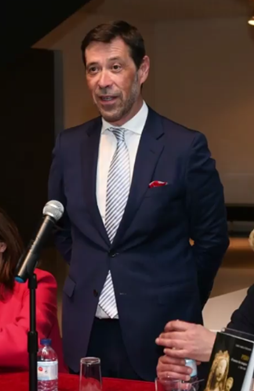
Fado is a music genre which can be traced to the 1820s in Lisbon, Portugal, but probably has much earlier origins. Fado historian and scholar Rui Vieira Nery states that "the only reliable information on the history of fado was orally transmitted and goes back to the 1820s and 1830s at best. But even that information was frequently modified within the generational transmission process that made it reach us today."

The Belém Palace, formally the National Palace of Belém,, is the current official residence of the president of the Portuguese Republic, the head of state of Portugal. Located in the Belém District of Lisbon, the palace's main façade fronts the Praça Afonso de Albuquerque, facing the Tagus River. A former residence of the Portuguese royal family, the Belém Palace complex is made up of various buildings, wings, courtyards, and gardens, built variously from the 18th to 21st centuries.

Rádio e Televisão de Portugal (RTP) is the public service broadcasting organisation of Portugal. It operates four national television channels and three national radio stations, as well as several satellite and cable offerings.

José Vital Branco Malhoa, known simply as José Malhoa was a Portuguese painter.
José Carlos Pereira Ary dos Santos, better known as José Carlos Ary dos Santos, or simply Ary dos Santos was a Portuguese poet, lyricist, and poetry reader. He published his first book, A liturgia do sangue, in 1963, although his family had already published a book of his poems, Asas, against his will, when he was just 15.

The Museu de José Malhoa, in Caldas da Rainha, is a regional Portuguese museum, that hosts the finest collection of the Portuguese naturalist painter José Malhoa. The museum building, the first purpose-built museum in Portugal, was constructed in 1940 and enlarged in 1950 and 1957. The museum's collection includes paintings, sculptures, medals, drawings and ceramics from the 19th and 20th centuries.

João Manuel Navarro Hogan was a Portuguese painter and printmaker.
Portugal participated in the Eurovision Song Contest 1999 with the song "Como tudo começou" written by Tó Andrade and Jorge do Carmo. The song was performed by Rui Bandeira. The Portuguese broadcaster Rádio e Televisão de Portugal (RTP) organised the national final Festival da Canção 1999 in order to select the Portuguese entry for the 1999 contest in Jerusalem, Israel. The competition took place on 8 March 1999 where "Como tudo começou" performed by Rui Bandeira emerged as the winner following the votes from 11 regional juries.

Pedro Cabrita Reis is one of the foremost visual artists of his generation and also one of Portugal’s most internationally renowned artists. His work features a wide variety of media – painting, sculpture, photography and drawing – and has been exhibited and included in numerous national and international museum collections. He lives and works in Lisbon.

The Museum-Residence of Dr. Anastácio Gonçalves is a former residential home built in the Art Nouveau style that has been converted into a museum of nineteenth-century Portuguese painting and of Art Nouveau art and artifacts. It is located in the civil parish of Avenidas Novas, in the municipality and Portuguese capital of Lisbon.

Álvaro Perdigão was a Portuguese painter.

Hélder António Moutinho Paiva dos Santos, artistically known as Helder Moutinho is a Portuguese singer and songwriter, and one of the most distinguished artists in the Fado genre. He's also the brother of two renowned Fado singers, Camané and Pedro Moutinho.
Mário Moniz Pereira was a teacher, sportsman, athlete, coach, songwriter and sports director. A noted athletics coach for both Sporting Clube de Portugal's athletics department and the Portuguese Athletics Federation where he worked as a technical director, he was also a vice president of Sporting CP. He was the coach of Olympic medalist Carlos Lopes, among other noted athletes. Established by Sporting Portugal, the international athletics meeting Meeting de Atletismo Professor Moniz Pereira is named in his honor.
Mariana Vasconcelos Bandhold, more popularly known by her stage name as Mariana Bandhold, is a Portuguese-American singer, actress, and songwriter from the Portugal. She was a contestant in the second season of The Voice Portugal.

Marta Dias is a São Toméan Portuguese singer of jazz, world music and fado who has recorded several solo albums and has additionally recorded and toured extensively with guitarist António Chainho. She has also appeared on several Hip hop releases, including the Ithaka song, Escape From The City Of Angels, which appeared in Columbia Pictures's feature film release, The Replacement Killers in 1998.

Francisca Joyce Munró, better known as Fanny Munró (1846–1926), was a Portuguese painter, of Scottish and Irish descent.

Eduarda Lapa was a painter and painting teacher who specialized in naturalist painting, especially still life, becoming known as the "flower painter" and the "ambassador of colours". An active feminist, she was the first woman to join the board of the Portuguese National Society of Fine Arts.

António Manuel Filipe Rocha Pimentel is a Portuguese academic and art historian currently the director of the Calouste Gulbenkian Museum in Lisbon, Portugal.

Casa Guilhermina is the seventh studio album by Ana Moura. Released on 11 November 2022, the album topped the national sales chart and was named as one of the albums of the year by various reputable Portuguese publications.
















